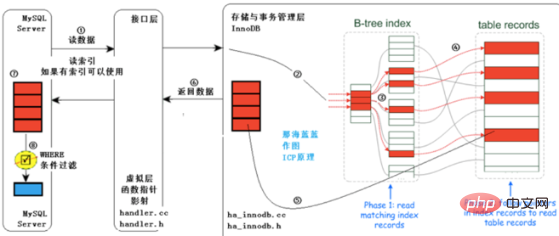Explanation of mysql index hit rules

First of all, let’s understand the leftmost matching principle, as follows:
1. First locate the query conditions of the sql, what are they, which ones are equivalent, which ones is a condition of scope.
2. Use equal-value conditions to hit the leftmost field of the index, and then hit the field from left to right in sequence, with the range at the end.
Analysis and explanation
1. The index of mysql is divided into clustered index and non-clustered index. The table of mysql is a clustered index organized table.
The clustering rules are: if there is a primary key, define the primary key index as a clustered index; if there is no primary key, select the first unique index that does not allow NULL; if not, use innodb's built-in rowid as the clustered index.
(Free learning video tutorial recommendation: mysql video tutorial)
Non-clustered index is also called secondary index, or auxiliary index.
2. MySQL’s index, whether it is a clustered index or a non-clustered index, is a B-tree structure. The leaf nodes of the clustered index store data, and the leaf nodes of the non-clustered index store the key and primary key values of the non-clustered index. The height of the B-tree is the height of the index.
3. Index height
The height of the clustered index determines the theoretical number of IOs to retrieve data based on the primary key. The theoretical IO times for reading data based on the non-clustered index should be added to the total number of IO times for accessing the clustered index. In fact, it may not require so much IO. Because the Page where the branch node of the index is located will be cached in the mysql memory due to multiple reads.
The default block size of mysql is 16K. The height of the index can be roughly estimated based on the length of the index column.
sql optimization is based on the where condition in the
SQL statement. Using the above extraction rules, it will eventually be extracted to Index Key (First Key & Last Key), Index Among Filter and Table Filter.
Index First Key is only used to locate the starting range of the index, so it is only used when indexing the first Search Path (traversing all the way along the root node of the index B tree to the correct leaf node position of the index) Use it and judge it once;
Index Last Key is used to locate the ending range of the index. Therefore, for every index record read after the starting range, you need to judge whether it has exceeded the Index Last Key. Range, if exceeded, the current query ends;
Index Filter is used to filter records in the index query range that do not meet the query conditions. Therefore, each record in the index range needs to be compared with the Index Filter. , if it does not meet the Index Filter, it will be discarded directly and continue to read the next record in the index;
Table Filter, this is the last line of defense for the where condition, used to filter records that have passed the previous index test. This The record at that time has satisfied the range formed by Index First Key and Index Last Key, and satisfied the conditions of Index Filter. The complete record is read back to the table and it is judged whether the complete record satisfies the query condition in Table Filter. Similarly, if not If satisfied, skip the current record and continue reading the next record in the index. If satisfied, return the record. This record meets all the conditions of where and can be returned to the front-end user
Analysis
What kind of process does a SQL statement need to go through to be executed?
When a sql statement is submitted to the mysql database for query, it needs to go through the following steps:
1. First, in the where parsing step, the query conditions in the current query statement are decomposed into each An independent condition unit;
2. Mysql will automatically split and reorganize the sql;
3. Then the where condition will perform index matching in the B-tree index part. If the index is hit, The specified table records location will be located. If there is no hit, all scans can only be used;
4. Return the corresponding data value based on the current query field.
As shown below:

Recommended related articles and tutorials: mysql tutorial
The above is the detailed content of Explanation of mysql index hit rules. For more information, please follow other related articles on the PHP Chinese website!

Hot AI Tools

Undresser.AI Undress
AI-powered app for creating realistic nude photos

AI Clothes Remover
Online AI tool for removing clothes from photos.

Undress AI Tool
Undress images for free

Clothoff.io
AI clothes remover

AI Hentai Generator
Generate AI Hentai for free.

Hot Article

Hot Tools

Notepad++7.3.1
Easy-to-use and free code editor

SublimeText3 Chinese version
Chinese version, very easy to use

Zend Studio 13.0.1
Powerful PHP integrated development environment

Dreamweaver CS6
Visual web development tools

SublimeText3 Mac version
God-level code editing software (SublimeText3)

Hot Topics
 1378
1378
 52
52
 MySQL: The Ease of Data Management for Beginners
Apr 09, 2025 am 12:07 AM
MySQL: The Ease of Data Management for Beginners
Apr 09, 2025 am 12:07 AM
MySQL is suitable for beginners because it is simple to install, powerful and easy to manage data. 1. Simple installation and configuration, suitable for a variety of operating systems. 2. Support basic operations such as creating databases and tables, inserting, querying, updating and deleting data. 3. Provide advanced functions such as JOIN operations and subqueries. 4. Performance can be improved through indexing, query optimization and table partitioning. 5. Support backup, recovery and security measures to ensure data security and consistency.
 MySQL: Simple Concepts for Easy Learning
Apr 10, 2025 am 09:29 AM
MySQL: Simple Concepts for Easy Learning
Apr 10, 2025 am 09:29 AM
MySQL is an open source relational database management system. 1) Create database and tables: Use the CREATEDATABASE and CREATETABLE commands. 2) Basic operations: INSERT, UPDATE, DELETE and SELECT. 3) Advanced operations: JOIN, subquery and transaction processing. 4) Debugging skills: Check syntax, data type and permissions. 5) Optimization suggestions: Use indexes, avoid SELECT* and use transactions.
 How to open phpmyadmin
Apr 10, 2025 pm 10:51 PM
How to open phpmyadmin
Apr 10, 2025 pm 10:51 PM
You can open phpMyAdmin through the following steps: 1. Log in to the website control panel; 2. Find and click the phpMyAdmin icon; 3. Enter MySQL credentials; 4. Click "Login".
 How to create navicat premium
Apr 09, 2025 am 07:09 AM
How to create navicat premium
Apr 09, 2025 am 07:09 AM
Create a database using Navicat Premium: Connect to the database server and enter the connection parameters. Right-click on the server and select Create Database. Enter the name of the new database and the specified character set and collation. Connect to the new database and create the table in the Object Browser. Right-click on the table and select Insert Data to insert the data.
 MySQL and SQL: Essential Skills for Developers
Apr 10, 2025 am 09:30 AM
MySQL and SQL: Essential Skills for Developers
Apr 10, 2025 am 09:30 AM
MySQL and SQL are essential skills for developers. 1.MySQL is an open source relational database management system, and SQL is the standard language used to manage and operate databases. 2.MySQL supports multiple storage engines through efficient data storage and retrieval functions, and SQL completes complex data operations through simple statements. 3. Examples of usage include basic queries and advanced queries, such as filtering and sorting by condition. 4. Common errors include syntax errors and performance issues, which can be optimized by checking SQL statements and using EXPLAIN commands. 5. Performance optimization techniques include using indexes, avoiding full table scanning, optimizing JOIN operations and improving code readability.
 How to create a new connection to mysql in navicat
Apr 09, 2025 am 07:21 AM
How to create a new connection to mysql in navicat
Apr 09, 2025 am 07:21 AM
You can create a new MySQL connection in Navicat by following the steps: Open the application and select New Connection (Ctrl N). Select "MySQL" as the connection type. Enter the hostname/IP address, port, username, and password. (Optional) Configure advanced options. Save the connection and enter the connection name.
 How to recover data after SQL deletes rows
Apr 09, 2025 pm 12:21 PM
How to recover data after SQL deletes rows
Apr 09, 2025 pm 12:21 PM
Recovering deleted rows directly from the database is usually impossible unless there is a backup or transaction rollback mechanism. Key point: Transaction rollback: Execute ROLLBACK before the transaction is committed to recover data. Backup: Regular backup of the database can be used to quickly restore data. Database snapshot: You can create a read-only copy of the database and restore the data after the data is deleted accidentally. Use DELETE statement with caution: Check the conditions carefully to avoid accidentally deleting data. Use the WHERE clause: explicitly specify the data to be deleted. Use the test environment: Test before performing a DELETE operation.
 How to use single threaded redis
Apr 10, 2025 pm 07:12 PM
How to use single threaded redis
Apr 10, 2025 pm 07:12 PM
Redis uses a single threaded architecture to provide high performance, simplicity, and consistency. It utilizes I/O multiplexing, event loops, non-blocking I/O, and shared memory to improve concurrency, but with limitations of concurrency limitations, single point of failure, and unsuitable for write-intensive workloads.




